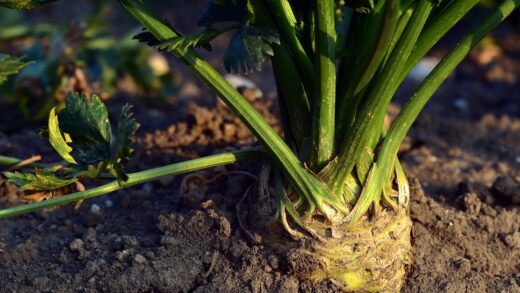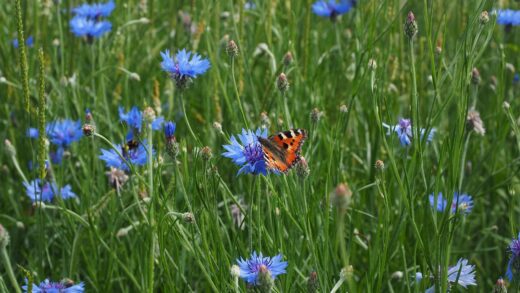Successfully overwintering the German iris is less about intensive protection and more about ensuring the plant enters its dormant period in a healthy, well-prepared state. These hardy perennials are naturally equipped to handle cold temperatures, but their survival and subsequent spring performance can be significantly enhanced by a few key preparatory steps in the autumn. The primary goals of winter preparation are to minimize the risk of disease, prevent pests from overwintering, and protect the rhizomes from the physical damage caused by the freezing and thawing cycles of the soil. A clean, well-drained iris bed is the foundation for a successful winter rest and a vibrant return in the spring.
The most critical task in preparing irises for winter is a thorough cleanup of the garden bed after the first hard frost. This sanitation process involves cutting back the foliage and removing all dead leaves and other debris from around the base of the plants. This is not merely for aesthetics; it is a crucial pest and disease control measure. The dead foliage provides the perfect location for iris borer moths to lay their eggs, and it also offers a safe harbor for fungal spores to survive the winter. By removing this material, the life cycles of these damaging organisms are interrupted, greatly reducing the potential for problems in the following season.
Good drainage, which is essential throughout the growing season, becomes even more critical during the winter months. Rhizomes that sit in cold, waterlogged soil are extremely susceptible to rot. In regions with heavy winter rains or snowmelt, ensuring that water can drain away freely from the iris bed is paramount. For new plantings, selecting a naturally well-drained site or creating a raised bed is the best long-term solution. For existing beds, making sure that surrounding soil or mulch has not washed over and buried the rhizomes is an important autumn check.
The question of whether or not to mulch irises for the winter depends heavily on the climate. In very cold regions where temperatures consistently drop well below freezing, a light layer of mulch can provide beneficial insulation. However, it must be applied correctly and at the right time. The mulch should only be applied after the ground has frozen solid, and it should never be placed directly on top of the rhizomes. A loose, airy material like straw or pine boughs laid over the entire bed is preferable, as it insulates the soil without trapping moisture around the plant crowns.
The importance of winter dormancy
Winter dormancy is a crucial and natural phase in the life cycle of the German iris. It is a period of rest and metabolic slowdown, triggered by decreasing day length and falling temperatures in the autumn. During this time, the plant ceases active growth and conserves its energy within the rhizome, preparing for the vigorous burst of growth required in the spring. This dormant period is not just a passive state of survival; it is essential for the proper development of the flower buds that were formed in the late summer. Many temperate perennials, including irises, require a certain period of cold exposure, known as vernalization, to flower properly.
The physiological changes that occur as the plant enters dormancy are remarkable. The cells within the rhizome alter their chemical composition, increasing the concentration of sugars and other solutes. This effectively acts as a natural antifreeze, lowering the freezing point of the water within the cells and protecting them from being damaged by ice crystals. This process of “hardening off” is gradual and is why a sudden, early deep freeze can be more damaging than the consistent cold of mid-winter. Proper autumn care ensures the plant is healthy and has sufficient stored energy to undergo this process effectively.
Respecting the dormant period means avoiding any cultural practices that might stimulate new growth late in the season. Fertilizing in the late summer or autumn is a significant mistake, as it can encourage the plant to produce tender new leaves that will not have time to harden off before the first frosts. This new growth is extremely vulnerable to cold damage and its production wastes valuable energy reserves that the plant needs to survive the winter and fuel its spring emergence. The last fertilizer application should be made no later than a month or so after flowering.
The duration and depth of dormancy are influenced by the specific climate and weather patterns of a given winter. In milder climates, the dormancy may be shorter and less profound, while in colder northern regions, the plant will remain completely inactive for many months. Regardless of the duration, the principle remains the same: the plant needs this period of rest. The gardener’s role is to ensure the plant enters dormancy in a clean, healthy state and is protected from the primary winter threats of rot and physical disturbance, allowing the natural process to unfold undisturbed.
Preparing the iris bed for winter
The single most important step in preparing an iris bed for winter is the autumn cleanup. This task should be undertaken after the first one or two hard frosts have caused the foliage to yellow and die back. Using a clean, sharp pair of scissors or secateurs, the leaf fans should be cut back to a height of about 10-15 centimeters. Some gardeners prefer to trim them into a neat fan shape, while others simply make a straight cut. The primary purpose is to remove the bulk of the old foliage, which is where iris borer eggs and fungal spores are most likely to be overwintering.
After cutting back the foliage, it is essential to meticulously clean the entire bed. All the cut leaves, along with any other fallen leaves, weeds, or organic debris, should be raked up and removed from the area. This material should not be added to a compost pile unless it is a “hot” pile that will reach temperatures sufficient to kill the pests and pathogens. For most home gardeners, the safest course of action is to bag the debris and dispose of it in the trash. This sanitation is the most effective non-chemical method for controlling the iris borer.
This is also an excellent time to inspect the rhizomes. With the foliage cut back, the rhizomes and the soil surface around them are clearly visible. Check to ensure that the tops of the rhizomes are still exposed to the air and have not been covered by soil erosion or accumulating mulch from other parts of the garden. If they are buried, gently scrape away the excess soil to re-expose them. Any weeds that have sprouted close to the clumps should be carefully removed by hand to avoid disturbing the iris roots.
Finally, assess the drainage of the bed one last time before winter sets in. If the area is in a low spot or is known to collect water, now is the time to take corrective action if possible. Digging a shallow trench or swale to divert water away from the bed can make a significant difference in preventing winter rot. Ensuring that the irises go into the winter in a clean, well-drained environment gives them the best possible chance of not just surviving, but thriving in the coming year.
The role of mulching
The use of mulch for overwintering German irises is a topic that requires careful consideration, as improper mulching can cause more harm than good. The primary purpose of a winter mulch is not to keep the ground warm, but rather to keep it frozen. It acts as a layer of insulation that moderates soil temperature fluctuations. The repeated cycles of freezing and thawing during the winter can cause the soil to expand and contract, a process known as frost heaving, which can push shallowly rooted plants like irises right out of the ground, exposing their roots to damaging cold and wind.
If mulching is deemed necessary, which is typically only in colder climates (USDA Zones 5 and below), the timing of its application is critical. Mulch should only be applied after the ground has frozen solid, usually in late autumn or early winter. Applying it too early, while the ground is still warm, can trap heat and moisture, which can delay the plant’s dormancy and create a damp environment around the rhizome that is conducive to rot. It can also provide a cozy winter home for voles and other rodents that may feed on the rhizomes.
The type of mulch used is also very important. A heavy, dense mulch like shredded hardwood or wet leaves should be avoided, as it will compact over the winter, trap excessive moisture, and suffocate the rhizomes. The ideal winter mulch for irises is something light, airy, and non-matting. Materials like straw, marsh hay, pine needles, or evergreen boughs are excellent choices. These materials provide insulation without holding water, and they allow for good air circulation. The mulch should be applied in a loose layer, about 5-10 centimeters deep, over the entire bed.
Equally important as the application is the timely removal of the winter mulch in the spring. As the weather begins to warm and the threat of severe hard freezes has passed, the mulch should be gently raked off the bed. Leaving it in place for too long can delay the warming of the soil, slowing the emergence of new growth. It also keeps the area around the rhizomes dark and damp just as spring growth begins, creating ideal conditions for rot and slugs. Removing the mulch allows the sun to warm the soil and the tops of the rhizomes, signaling the plant to break dormancy and begin its new season of growth.
Winter care in different climate zones
Winter care for German irises varies significantly depending on the regional climate. In cold climates, typically USDA Zone 6 and colder, the primary concerns are protecting the rhizomes from deep freezes and the damaging effects of frost heave. In these regions, the autumn cleanup of cutting back foliage is essential. Applying a light, airy mulch such as straw or pine boughs after the ground has frozen solid is a highly recommended practice. This layer of insulation helps to keep the soil at a more constant frozen temperature, preventing the repeated freeze-thaw cycles that can push rhizomes out of the ground.
In temperate and transitional climates (approximately USDA Zones 7 and 8), winter conditions can be variable, with periods of freezing weather alternating with mild, rainy spells. In these zones, the most significant winter threat is often rot caused by cold, wet soil, rather than extreme cold itself. Therefore, the focus of winter care should be on ensuring impeccable drainage. Mulching is generally not necessary or recommended in these areas, as it can trap too much moisture around the rhizomes. The autumn cleanup remains a crucial step to prevent pests and diseases from overwintering.
In mild winter climates (USDA Zone 9 and warmer), German irises may not enter a true, deep dormancy. The foliage often remains semi-evergreen throughout the winter. In these regions, the primary winter care task is sanitation. It is still a good practice to perform a thorough cleanup in the autumn, removing any yellowing or diseased leaves to improve air circulation and reduce pathogen load. Supplemental watering may be necessary during dry winter periods, but the principle of allowing the soil to dry out between waterings still applies. The risk of rot remains a concern, especially during cool, rainy winters.
Regardless of the climate zone, a final inspection before winter is always a good idea. For newly planted irises, especially those planted late in the season, it’s important to check that they are firmly anchored in the soil. A gentle tug on a leaf fan can confirm this; if it feels loose, gently firm the soil around the rhizome. This simple check can prevent a poorly rooted rhizome from being dislodged by winter winds or frost heave, ensuring it is well-positioned to begin strong growth when spring arrives.


















